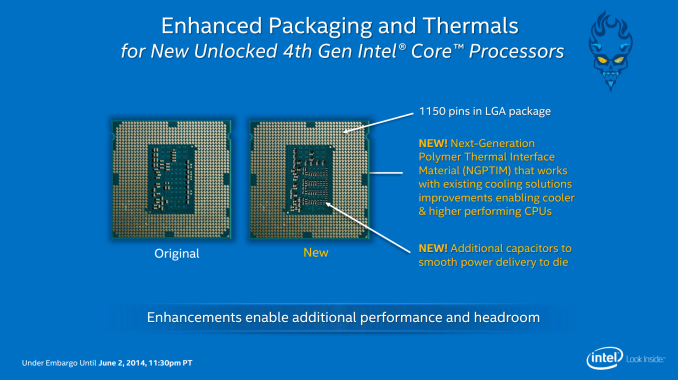Devil’s Canyon Review: Intel Core i7-4790K and i5-4690K
by Ian Cutress on July 11, 2014 10:00 AM EST- Posted in
- CPUs
- Intel
- Haswell
- i7
- Overclocking
- Devil's Canyon
- i5
- 4790K
- 4690K
Conclusions
End-users with CPU intensive workloads always feel justified in requesting for more performance. The only question is if that performance is required at the expense of power, and if the CPU company feel satisfied they can offer a higher performance component with absolute stability. Over the past three generations, Intel CPUs at equal frequency have offered a 5-10% performance boost over the previous generation, usually around the same power envelope. Because 2014 would seem to be a year where there is no major generation change for the mainstream market segment, in order to provide that 10% boost, they have had to go directly at clock speeds.
With the clock speed change, the package is also adjusted in two distinct ways. The first is to add extra decoupling capacitors on the PCB, allowing the voltage regulator on the die to deliver cleaner power to where it needs to go. The second addresses the issue of temperature, whereby the heat generated by the processor is removed. By adjusting the thermal interface material, Intel hopes to have a CPU that is ~10C cooler than the original Haswell CPUs at the same frequency and voltage. This latter part is directly observable, and even when overclocked, the ~10C temperature difference is very much visible.
This leads on to overclocking, the supposed reason for the release of Devil’s Canyon. Lisa Graff, VP and GM of Intel’s Desktop Client Platform Group, indicated in a press call before Computex that the lead design teams on Devil’s Canyon had six months to make the changes, and that the CPUs were aimed at addressing concerns levied at Intel from users who enjoy overclocking. The main concerns were the variability of the headroom of the Haswell CPU line, where some CPUs could only manage +5% whereas others gave +20% extra frequency, along with high temperatures at low clock speeds. By releasing the i7-4790K at 4.0 GHz/4.4 GHz Turbo, this ensures that the out-of-the-box i7-4790K has a better performance than the lowest performing overclocked i7-4770K CPUs. The adjustment in the thermal interface material (which we suspect is a change in the ceramic filler to an aluminum oxide or derivative therein) also gives more headroom for the i7-4790K CPUs that might have been temperature limited otherwise.
For our overclocking performance, both of our CPUs were hitting their voltage limitations as a result of the temperature adjustment. At the top end of our final overclocks, in order to adjust +100 MHz to be fully stable required a large jump of +0.100 volts, pushing the CPU voltage outside of the recommended window for a 24/7 stable Haswell-based processor. Both the i7-4790K and the i5-4690K in our testing gave 4.7 GHz benchmark stable, 100 MHz more than our first i7-4770K sample and 500 MHz more than our second i7-4770K sample.
This ends up being the main selling point for the overclocking end-user: if you own a relatively mediocre Sandy Bridge, Ivy Bridge or Haswell CPU, and have CPU limited throughput, there can be performance gains by investing into the Devil’s Canyon (CPU + Z97 motherboard or Z87 with BIOS updates) ecosystem. These are ‘enhancements’ that Intel should build on for the future, and never remove. I am sure that many enthusiasts would like to see a return to soldering the IHS on, or a single version with this feature.
For users relying on an Ivy Bridge stock system, the i7 Devil’s Canyon can offer a 17% increase over the i7-3770K for CPU benchmarks. For those that need the fastest single-thread VT-d enabled processor according to Intel's specification pages, the i7-4790K also affords that opportunity.
Users that are looking for the fastest GPU for gaming, at 1080p, might not be impressed by either the i5 or i7 Devil’s Canyon. At least in our testing, we saw no improvement from Ivy Bridge to Devil’s Canyon. One might argue that the story would be different for online gaming, or at larger resolutions, however for the latter there is more emphasis on upgrading the GPU over the CPU. While some hardware setups offer this mainstream CPU with three and four-way GPU gaming, typically we end up recommending the extreme platform due to fewer PCIe switches required.
The next question is oriented towards the future. Will the next generation of Intel CPUs perform better than Devil’s Canyon? The expected release date of Broadwell CPUs is still unknown, as is the extent of Intel's desktop offerings. Some media are expecting Broadwell to be more IGP focused as a platform, given the initial expectations of no desktop parts. To put this into perspective: if Broadwell offers a 5-10% IPC increase, Intel has to offer a 4.0 GHz / 4.4 GHz Turbo version in order to make their fastest mainstream processor even faster. However, given the history of Intel’s releases, if they release a top end i7, it will most likely be a 3.6 GHz / 4.0 GHz Turbo part, and offer the same performance as Devil’s Canyon. We cannot predict the overclocking potential, or if Intel is going to migrate the ‘enhanced overclocking features’ of Devil’s Canyon to the new parts. If this is the case, Intel will have to offer a new 'feature' to help sell the new high end parts.
The user has to hedge their bets – when is Broadwell coming to market, and is there going to be a large OC version of Broadwell, the equivalent of Devil’s Canyon is to Haswell? We are currently looking at 5 months away from Broadwell-Y (also known as Core-M) based on Intel announcements but no indication yet when Broadwell-DT is released, meaning an investment in Devil’s Canyon gives the top class mainstream processor based system until then.
The next piece of the puzzle is Haswell-E where many sources, such as CPU-World, are quoting that the low end SKU (an i7-5820K going by previous naming schemes) will be a six-core 3.3 GHz CPU with some amount of turbo. Historically Intel has charged roughly the same amount for the lowest Enthusiast CPU and the top Mainstream CPU, although this time the lowest Enthusiast CPU will have two more cores. So until Haswell-E is released, along with DDR4 and the X99 chipset, Devil’s Canyon might sit in the ‘should I wait’ category. But if we were looking at upgrading that main system today, based on CPU limited workloads, the i7-4790K is a well recommended choice.














117 Comments
View All Comments
leoblaze9 - Friday, July 11, 2014 - link
WOW! what happened in the particle simulation test? that difference is STAGGERING!!just one of the prime examples of the benefits of using both cpu and gpu together as a cohesive whole rather than two discrete entities. I am genuinely amazed at AMD's engineering! kudos AMD....you deserved that one!
MamiyaOtaru - Saturday, July 12, 2014 - link
possible reason they don't use solder anymore: http://iweb.tms.org/PbF/JOM-0606-67.pdfspecifically:
"At higher thermal cycles the cracks have propagated across the entire center region of the die and significantly degrade thermal performance.This failure mechanism is predominant on small die form factors. The center degradation mode is not observed, as the die size is increased to the large and medium sizes"
Smaller die sizes are more likely to see cracks in the solder spread to the middle, significantly harming thermal performance. Ivy Bridge / Haswell with their process shrink have smaller die sizes, perhaps making solder unworkable as a TIM
ZeDestructor - Monday, July 14, 2014 - link
Interesting....Galatian - Saturday, July 12, 2014 - link
I agree: 4,6 GHz seems to be the sweet spot. Mine uses 1,25V core and a 0,175 V offset uncore to reach Ringbus parity. I needed 1,294V for 4,7 and 1,345 for 4,8. Temperatures were off the hook though and this is with a custom-liquid loop with 2 480mm radiators (one monsta and one 25mm) as well as Liquid Ultra. Stability tested with Prime95 24h and IBT 20 runs on maximum (kudos to IDK in the forum for is stability guide).It is an improvement as it seems to be easier to get a rock stable CPU, but temperatures still are a problem. The thing is: I don't believe a better solution would ultimately change anything. I mean when you clearly see that the sweet spot is 4,6 GHz with 1,25V one would assume that 5 GHz probably needs something like 1,5V and that's just dangerously high IMHO.
Also what I realized is that DC needs a lot less Input Voltage. Stock was at 1,8V, but even with my overclock I could dial it all the way down to 1,5V, which is amazing. Ian have you checked how low you can go? (I can't believe I just said that...). Also how exactly can Prime95 ruin a CPU? I still consider it gold standard, as it would show problems within minutes when other stress tests would happily run for hours. I know it is a hassle to let it run for 24h but nothing gets close to rock stable setting then Prime95.
pierrot - Saturday, July 12, 2014 - link
Now we just need the OC'd Anniversary Pentium benchmarks added in!andrew-1983 - Saturday, July 12, 2014 - link
The image is blurry, but the batch number of the 4790k lookslike L336... which if I'm decoding it right means 2013 36th week,
around 2013 September. Does that matter that you are testing
a 10 month old CPU for overclocking?
Galatian - Saturday, July 12, 2014 - link
That number stand for the time the silicon was started to be manufactures or something alike...(read the forums...it has been mentioned several times now)...there are a lot more step until a final chip is put together, so it really is not a 10 month old processor.andrew-1983 - Sunday, July 13, 2014 - link
Ok I get that, but when the retail cpu we buy has an L418C164 that's stillan 8-month difference, whatever the numbers actually mean, and there is
a new microarchitecture or die shrink in every year..
What I'm trying to say is overclockability should be tested with
silicon similar to what people will buy after reading the review.
bludragon - Saturday, July 12, 2014 - link
My chip need 1.237v to be prime95 stable at 4x4.4GHz. This is the stock vid for aturbo on 1 or 2 cores. Using an NH-D14 it would throttle on cores 2 and 3 (so hitting 105+deg?) withing a few minutes. Delidded it maxes at 91 degrees, so at least 15 degrees better and I used the Noctua TIM. I tried 4.6 but the voltage nneds to be 1.27 or higher as it throttled again there.ratbert1 - Saturday, July 12, 2014 - link
With an i5-2500k I still do not see the need to upgrade. I have run at 4Ghz with speedstep and voltage on auto for 3 years. My synthetics will be slower, but using an SSD my everyday usage is fine. Just ran Bioshock Infinite benchmark and got 115 fps average and 41 fps min. @1080p on GTX770 running stock speed(card is OC'd version though). Hopefully Broadwell early next year.